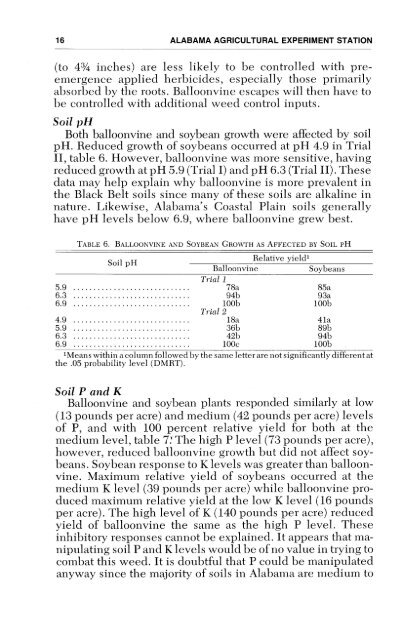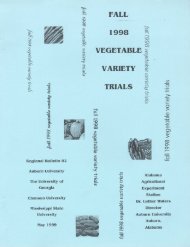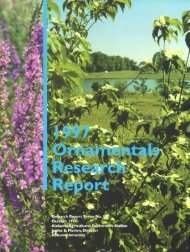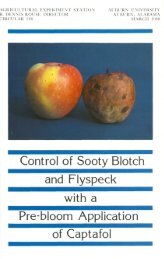Balloonvine Biology and Control in Soybeans - Auburn University ...
Balloonvine Biology and Control in Soybeans - Auburn University ...
Balloonvine Biology and Control in Soybeans - Auburn University ...
You also want an ePaper? Increase the reach of your titles
YUMPU automatically turns print PDFs into web optimized ePapers that Google loves.
16<br />
ALABAMA AGRICULTURAL EXPERIMENT STATION<br />
(to 43/4 <strong>in</strong>ches) are less likely to be controlled with preemergence<br />
applied herbicides, especially those primarily<br />
absorbed by the roots. <strong>Balloonv<strong>in</strong>e</strong> escapes will then have to<br />
be controlled with additional weed control <strong>in</strong>puts.<br />
Soil pH<br />
Both balloonv<strong>in</strong>e <strong>and</strong> soybean growth were affected by soil<br />
pH. Reduced growth of soybeans occurred at pH 4.9 <strong>in</strong> Trial<br />
II, table 6. However, balloonv<strong>in</strong>e was more sensitive, hav<strong>in</strong>g<br />
reduced growth at pH 5.9 (Trial I) <strong>and</strong> pH 6.3 (Trial II). These<br />
data may help expla<strong>in</strong> why balloonv<strong>in</strong>e is more prevalent <strong>in</strong><br />
the Black Belt soils s<strong>in</strong>ce many of these soils are alkal<strong>in</strong>e <strong>in</strong><br />
nature. Likewise, Alabama's Coastal Pla<strong>in</strong> soils generally<br />
have pH levels below 6.9, where balloonv<strong>in</strong>e grew best.<br />
TABLE 6. BALLOONVINE AND SOYBEAN GROWTH AS AFFECTED BY SOIL PH<br />
Soil pH<br />
Relative yield 1<br />
<strong>Balloonv<strong>in</strong>e</strong> <strong>Soybeans</strong><br />
Trial 1<br />
5.9 .............................<br />
6.3 ............................<br />
6.9 .............................<br />
78a<br />
94b<br />
100b<br />
85a<br />
93a<br />
100b<br />
Trial 2<br />
4.9 .............................<br />
5.9 .............................<br />
6.3 .............................<br />
18a<br />
36b<br />
42b<br />
41a<br />
89b<br />
94b<br />
6.9 ............................. 100c 100b<br />
'Means with<strong>in</strong> a column followed by the same letter are not significantly different at<br />
the .05 probability level (DMRT).<br />
Soil P <strong>and</strong> K<br />
<strong>Balloonv<strong>in</strong>e</strong> <strong>and</strong> soybean plants responded similarly at low<br />
(13 pounds per acre) <strong>and</strong> medium (42 pounds per acre) levels<br />
of P, <strong>and</strong> with 100 percent relative yield for both at the<br />
medium level, table 7. The high P level (73 pounds per acre),<br />
however, reduced balloonv<strong>in</strong>e growth but did not affect soybeans.<br />
Soybean response to K levels was greater than balloonv<strong>in</strong>e.<br />
Maximum relative yield of soybeans occurred at the<br />
medium K level (39 pounds per acre) while balloonv<strong>in</strong>e produced<br />
maximum relative yield at the low K level (16 pounds<br />
per acre). The high level of K (140 pounds per acre) reduced<br />
yield of balloonv<strong>in</strong>e the same as the high P level. These<br />
<strong>in</strong>hibitory responses cannot be expla<strong>in</strong>ed. It appears that manipulat<strong>in</strong>g<br />
soil P <strong>and</strong> K levels would be of no value <strong>in</strong> try<strong>in</strong>g to<br />
combat this weed. It is doubtful that P could be manipulated<br />
anyway s<strong>in</strong>ce the majority of soils <strong>in</strong> Alabama are medium to
















